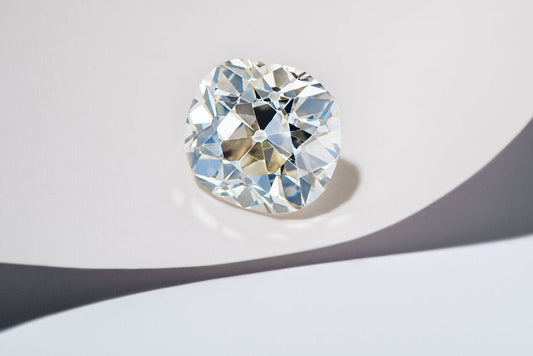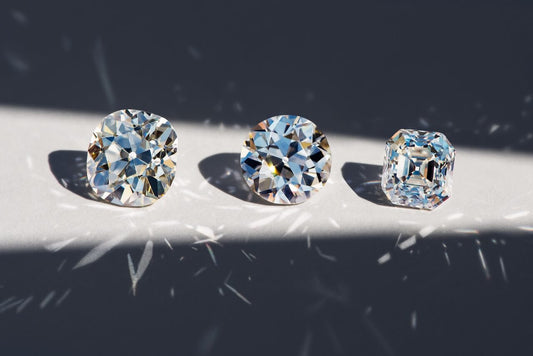Antique diamonds are packed with beauty, charm, and history. The unique, handcrafted qualities of these incredibly rare stones make them a one-of-a-kind choice for those with an especially sophisticated and inimitable style.
WHAT IS AN ANTIQUE DIAMOND?
Antique diamonds are diamonds that were cut by skilled artisans by hand, and often by candlelight, primarily in the 1800s and early 1900s. These are rare and collectable diamonds with a unique charm defined by the impression of the artist (as opposed to computers and laser technology) who cut them for beauty. They are an excellent choice for the environmentally conscious customer and those with one-of-a-kind style. And, genuine antique diamonds are becoming increasingly coveted and rare, making them even more sought after today. Read on to discover more about the types, features, and rarity of antique diamond cuts.
—
ROSE CUTS
Time period: 1500s - today
THE STORY
Unlike the Table Cut (named for its flat top, which is table-like in appearance), the Rose Cut wasn’t designed for octahedral-shaped rough. Instead, it provided an efficient and appealing way to use flattened, shallow, or “macle” shaped rough. Macle is a term used in the diamond trade to describe a flat, triangular, rough diamond.
SHAPE AND STYLE
Rose Cut diamonds have flat bottoms and a domed faceted top. The Rose Cut’s facets produce bright reflections of light, but little fire.
RARITY LEVEL
High. Genuine antique Rose Cuts are incredibly rare to find. However, they are still cutting the Rose Cut style in India today using modern diamond rough.
WHY WE LOVE IT
We love the rose cut for its large face up appearance, its carat weight, and its soft “twinkle”.

—
PERUZZI CUT
Time period: c. 17th century
THE STORY
The Peruzzi Cut was introduced by Vincent Peruzzi, a polisher from Venice in the early 17th century, and is considered one of the first "brilliant cuts" created. Before this time, most diamonds were cut in a simple facet arrangement with eight crown facets. Peruzzi tripled the amount of facets to 33 ("triple-cut") which added a lot of fire and sparkle to the diamond.
SHAPE AND STYLE
They are generally extremely deep (around 80-90 per cent deep), with broad facets, a prominent culet and a stunning squarish shape.
RARITY LEVEL
Extremely high. Even in their time, Peruzzi Cut diamonds were incredibly rare, as the majority of diamonds in the 17th century were being cut as Rose Cuts or Single Cuts. It's remarkable that such treasures can still be found today. ‘Out of a parcel of 300 to 400 genuine antique diamonds, sometimes you are lucky to find one Peruzzi cut,’ says CUSHLA WHITING Gemologist, Hamish.
WHY WE LOVE IT
We love the Peruzzi Cut for its hard-to-find factor, unusual octagonal shape, and high carat weight.

—
OLD MINE CUT
Time period: c. 1700-1890
THE STORY
The unmatched brilliance and fire/scintillation of the Old Mine made it the most popular cut of the eighteenth and nineteenth centuries. Today, the Old Mine Cut is in high demand for use in engagement rings. These diamonds get their name from how they were sourced—from the “old mines”.
SHAPE AND STYLE
A CUSHLA WHITING favourite, the Old Mine Cut is typically cushion shaped with 58 facets, a small table, high crown, deep pavilion, and large culet.
RARITY LEVEL
High. Arguably one of the most beautiful diamond cuts of all time, Old Mine Cuts are incredibly rare and sought after.
WHY WE LOVE IT
We love the Old Mine Cut for its blocky and broad flashes of light return, and its chunkier appearance. Hamish our Gemologist meticulously selects out the most beautiful examples of Old Mine Cut diamonds by eye from the Antwerp Diamond Bourse for our collection.

—
OLD EUROPEAN CUT
Time period: c. 1890’s - 1930
THE STORY
The Old European Cut was the precursor to today’s modern Brilliant Cut. The invention of the steam-driven diamond bruting machine in the late 1800s allowed cutters to fashion an evenly-rounded girdle for the first time, as opposed to a cushion shape like the Old Mine. This significant advance in the cutting process led to the creation of the Old European Cut.
SHAPE AND STYLE
Possessing the same number of facets as the Old Mine Cut and similar proportions (high crown, small table, shallow pavilion) but displaying a rounded girdle for the first time, the Old European Cut was seen as an advancement of the Old Mine Cut and rapidly became the most popular cut of the early 20th century.
RARITY LEVEL
High. There are very few genuine Old European Cut diamonds on the market at any given time.
WHY WE LOVE IT
We love the Old European Cut for its rounded shape, broad, chunky facets, high crown and “inner fire”—the multi-coloured flashes of colour that come from within the diamond.

—
ASSCHER CUT
Time period: c. 1920-1930
THE STORY
Invented by the Royal Asscher Diamond Company in 1902 the Asscher Cut didn’t gain popularity until the Art Deco era in the 1920s. This diamond is one of the very first patented diamond cuts in the world.
SHAPE AND STYLE
Classic Asscher Cut diamonds are cut into squares and resemble Emerald Cuts which are rectangular. But Asscher Cut diamonds have larger step facets, a higher crown, and a smaller table. The corners are cropped which give the shape an octagonal appearance. The Asscher Cut is typically more brilliant than its cousin the Emerald Cut.
RARITY LEVEL
Extremely High. Asscher Cut diamonds from the 1920s and 1930s are incredibly rare.
WHY WE LOVE IT
For its Art Deco appeal and striking geometric appearance.

—
TRANSITIONAL CUT
Time period: 1920-1940
THE STORY
The Transitional Cut was short-lived, but incredibly important in cutting history. This cut, also known as Early American Cuts or Early Modern Cuts, bridged the gap between the Old Cuts and the Modern Round Brilliant. Transitional Cuts were the precursor to the Modern Round Brilliant. They featured more precise cutting, and therefore a symmetry and brilliance, which had never been seen before. Their proportions began to take the shape of Modern Round Brilliants which were mathematically perfected by Tolkowsky, eventually resulting in the very standardised Modern Round Brilliant Cuts of today.
SHAPE AND STYLE
The Transtional Cut features a round cut, with a larger table, lower crown, smaller culet and shorter pavilion than the previous Old European Cut, however still possesses some of its characteristics—including an unfaceted girdle.
RARITY LEVEL
Very high. Because it was only used for a few decades, Transitional Cuts are becoming increasingly rare to find.
WHY WE LOVE IT
This classic beauty offers the best of both worlds—it’s dazzling and symmetrical like a modern cut diamond, yet it comes laden with the history and romance of a vintage piece.

IN SUMMARY
It’s fascinating to see how diamond cutting has evolved over the last 500 years as technology has advanced. These antique gems are truly rare masterpieces and undeniably the most beautiful of all diamonds.
Want to browse our meticulously curated collection of antique diamonds?


